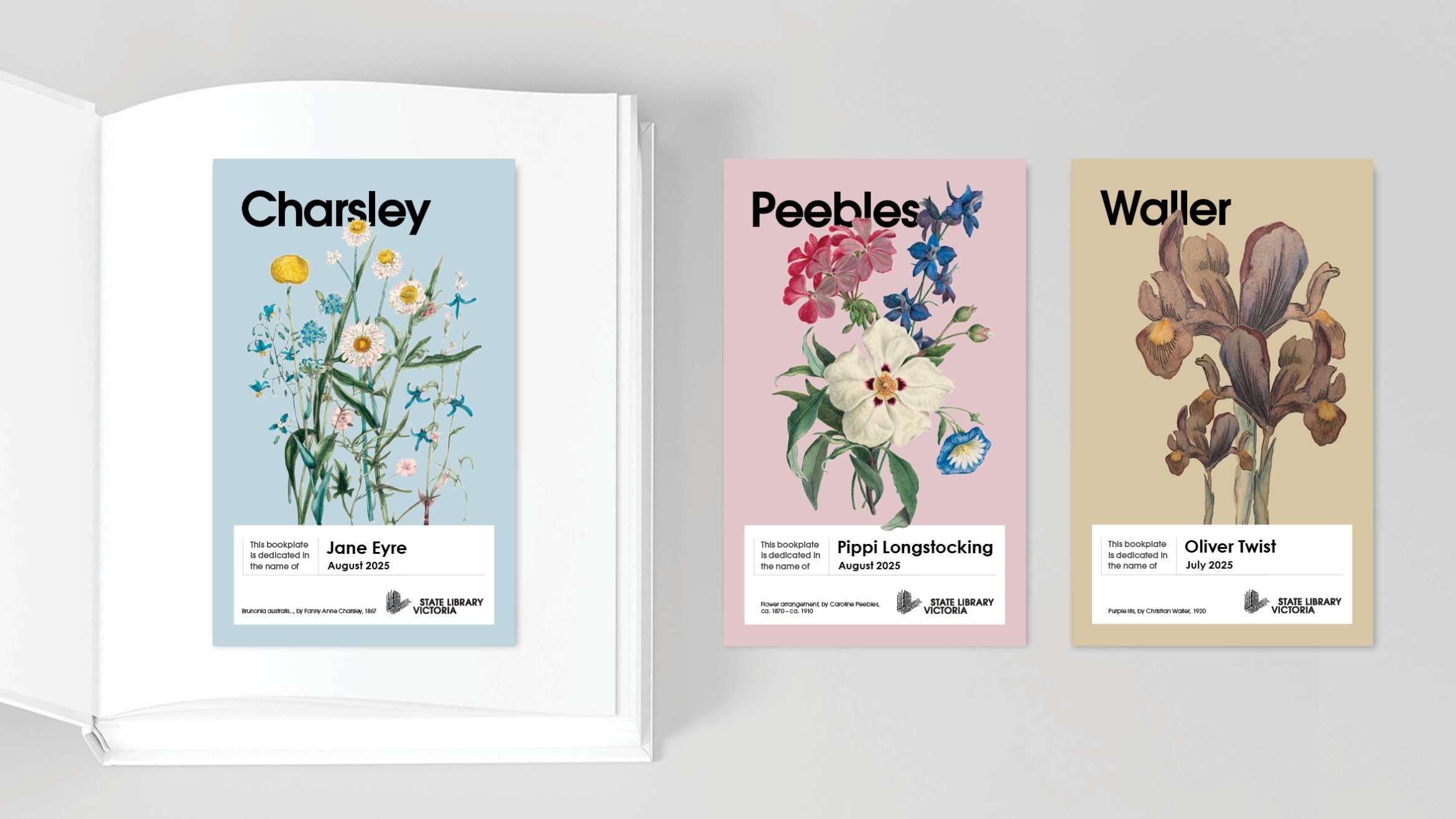Become a bookplate donor

Bookplates are beautifully illustrated, personalised labels placed on the inside front cover of a new book entering the State Collection.
By donating a bookplate, your name – or dedication to someone important to you – will be there for the entire life of the book. It’s one of the most tangible ways you can show your support for State Library Victoria, helping us to grow and preserve our collection while safeguarding our stories for future generations.
Leave a lasting legacy at State Library Victoria
Every year, three new bookplate designs are offered to our Library community, each including a gorgeous illustration from the Rare Books and Pictures collections.
Our 2025 series features botanical works by three female artists who contributed to Victoria’s artistic legacy:
- Purple iris by Christian Waller (1894–1954) – $175
- Brunonia australis by Fanny Anne Charsley (1828–1915) – $500
- Flower arrangement by Caroline Peebles (1826–1911) – $1000.
Previous supporters have dedicated their bookplate to a loved one, or in memory of parents or family members. It’s a heartfelt way to commemorate someone special, celebrate a milestone and support a worthy cause.
The book will live at the Library, ensuring it’s preserved for everyone to enjoy and leaving your mark on the State Collection.
Your donation is tax deductible and we welcome you to come and view the book once it has been added to the collection.
About the illustrators
Christian Waller (1894–1954)
Christian Waller (née Yandell) was an Australian printmaker, illustrator, muralist and stained-glass artist. In 1909, at age 15, she moved to Melbourne, where she studied at the National Gallery School under Frederick McCubbin, a prominent member of the Heidelberg School art movement.
Waller was one of the few acknowledged professional female stained-glass artists at the time, and a leading book illustrator. During the 1920s she won acclaim as the first Australian artist to illustrate Alice in Wonderland. After the Second World War, she had a five-year waiting list for her commissions. Her glass still adorns over 20 churches in Victoria and New South Wales.
As a printmaker, Waller is best known for her bold linocuts printed on her own press, including many bookplates for friends. She exhibited extensively and her work was appreciated by critics of the day and much sought after.
View the bookplate image in the collection: Purple iris from My book of flowers, Christian Yandell, 1920, H93.150/60
Fanny Anne Charsley (1828–1915)
Fanny Anne Charsley was a botanical artist and collector. Born in Buckinghamshire in the UK, she travelled to Australia with her family and settled in Melbourne and remained here for 10 years before returning home. During her time in Australia, she painted the local flora and became a student of the Victorian Government botanist Baron Ferdinand von Mueller, who later became director of Melbourne’s Royal Botanic Gardens. She collected plant specimens for von Mueller who later named a species of Australian paper daisy, Helipterum charsleyae, in her honour (since reclassified as Rhodanthe charsleyae).
Charsley's paintings were of excellent technical quality – not only works of art but botanically accurate. When she returned to England, she lithographed her drawings onto stone herself. These were hand-coloured and then published in 1867 in a book titled The wildflowers around Melbourne – one of the first books on Victorian flora aimed at a general audience. It proved popular and is one of a small number of botanical books published by women in Australia in the latter half of the 19th century.
View the bookplate image in the collection: Brunonia australis from The wildflowers around Melbourne, Fanny Anne Charsley, 1867, RARELTF 581.9945 C38W
Caroline Peebles (1826–1911)
Caroline Peebles was born in England (her father is reputed to have been a painter to Queen Victoria) before she migrated to Australia in 1855. Between the years of 1870 and 1910, the talented artist completed a stunning series of watercolours of flowers, vegetables and fruit, which has been acquired into the State Collection thanks to a gift from Ms Eileen Dillon-Smith.
The collection featured over 100 watercolours – among them, vivid illustrations of apple blossom, carnations, marigold, Sturt’s desert pea, blueberries, red currants, heirloom tomatoes and peas in their shell – plus a wistful poem, The Primrose, written by Peebles in her later life and published in The Otago Witness in 1897.
In the 1880s, Peebles exhibited her work at the Melbourne International Exhibition – held in the newly built Royal Exhibition Building in Carlton Gardens – alongside her two daughters Eva and Florence, who also became artists. Creativity was certainly in the blood: her son Norman was an architect (of Bates, Peebles and Smart) who went on to design State Library Victoria’s iconic domed reading room.
View the bookplate image in the collection: Flower arrangement from Album of watercolours of flowers, vegetables and fruit, Caroline Peebles, c.1870-1910, H2010.77/12
